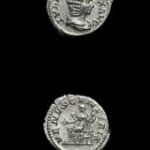Silver Denarius of Empress Julia Domna, 211 CE - 217 CE
Silver
C.7233
Obverse: Bust of the Empress Facing Right Reverse: Venus, Seated to the Left, Holding a Sceptr Empress Julia Domna was the second wife of the Roman emperor Septimius Severus (reigned...
Obverse: Bust of the Empress Facing Right
Reverse: Venus, Seated to the Left, Holding a Sceptr
Empress Julia Domna was the second wife of the Roman emperor Septimius Severus (reigned 193-211) and a powerful figure in the regime of his successor and their son, the emperor Caracalla. Julia was a Syrian (Domna being her Syrian name) and was the daughter of the hereditary high priest Bassianus at Emesa (now Homs) in Syria and elder sister of Julia Maesa. Domna gathered about her in Rome a group of philosophers and other intellectuals whose activities are best known through the writings of Philostratus. After Severus' death, the murderous rancor of her two sons, the joint emperors Caracalla and Geta, culminated in the assassination of Geta by Caracalla in her presence. When Caracalla (reigned 211-217) was on campaign, he left her in control of most of the civilian administration, demonstrating the significant status of this woman in a society dominated by men.
How many hands have touched a coin in your pocket or purse? What eras and lands have the coin traversed on its journey into our possession? As we reach into our pockets to pull out some change, we rarely hesitate to think of who might have touched the coin before us, or where the coin will venture to after it leaves our hands. More than money, coins are a symbol of the state that struck them, of a specific time and location, whether contemporary currencies or artifacts of a long forgotten empire. This stunning hand-struck coin reveals an expertise of craftsmanship and intricate sculptural detail that is often lacking in contemporary machine-made currencies. This ancient coin is a memorial an powerful woman passed from the hands of civilization to civilization, from generation to generation that still appears as vibrant today as the day it was struck.
Reverse: Venus, Seated to the Left, Holding a Sceptr
Empress Julia Domna was the second wife of the Roman emperor Septimius Severus (reigned 193-211) and a powerful figure in the regime of his successor and their son, the emperor Caracalla. Julia was a Syrian (Domna being her Syrian name) and was the daughter of the hereditary high priest Bassianus at Emesa (now Homs) in Syria and elder sister of Julia Maesa. Domna gathered about her in Rome a group of philosophers and other intellectuals whose activities are best known through the writings of Philostratus. After Severus' death, the murderous rancor of her two sons, the joint emperors Caracalla and Geta, culminated in the assassination of Geta by Caracalla in her presence. When Caracalla (reigned 211-217) was on campaign, he left her in control of most of the civilian administration, demonstrating the significant status of this woman in a society dominated by men.
How many hands have touched a coin in your pocket or purse? What eras and lands have the coin traversed on its journey into our possession? As we reach into our pockets to pull out some change, we rarely hesitate to think of who might have touched the coin before us, or where the coin will venture to after it leaves our hands. More than money, coins are a symbol of the state that struck them, of a specific time and location, whether contemporary currencies or artifacts of a long forgotten empire. This stunning hand-struck coin reveals an expertise of craftsmanship and intricate sculptural detail that is often lacking in contemporary machine-made currencies. This ancient coin is a memorial an powerful woman passed from the hands of civilization to civilization, from generation to generation that still appears as vibrant today as the day it was struck.



